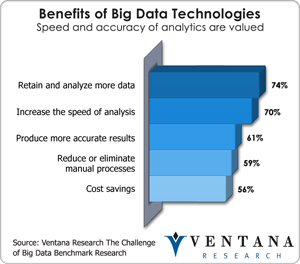Exactly what is the relationship between workforce analytics and big data? Most of the use cases for big data seem to revolve around marketing, social media and customer service initiatives where unstructured data sources reveal big value. Our research into big data analytics suggests a prime benefit of big data is in the ability to retain and analyze larger amounts of data and to increase the speed of analysis. However, workforce analytics does not suffer from an overwhelming amount of data, but rather from the inability to apply meaningful analytics to the data organizations already have.
data sources reveal big value. Our research into big data analytics suggests a prime benefit of big data is in the ability to retain and analyze larger amounts of data and to increase the speed of analysis. However, workforce analytics does not suffer from an overwhelming amount of data, but rather from the inability to apply meaningful analytics to the data organizations already have.
Ventana Research has been covering workforce analytics and the broader world of human capital management for years. While workforce analytics may seem like new wine in old bottles for some, it is gaining visibility, and companies are taking note. Tom Davenport’s recent article in Harvard Business Review outlining the linkages between employee and company success, while well-publicized, is not particularly new. The book “In Search of Excellence” came to some of the same conclusions 30 years ago. However, fundamental shifts in the workforce and macroeconomic and demographic changes are driving these arguments forward alongside new demand for workforce measurement and analytics:
- Structural economic shifts: Company success 30 years ago was grounded in efficient use of tangible assets such as plants and equipment. Today, company success is more grounded in intangible assets such as intellectual capital and brand loyalty. These assets, in turn, are driven by employee engagement and performance, or human capital, yet companies lack the capability to effectively measure and analyze their investments in this area.
- Demographics: According to data from the 2010 U.S. Census, America's 78 million baby boomers have begun turning 65 at a rate of one every 10 seconds, or 3 million to 4 million per year. Knowledge transfer and succession planning are beginning to move to center stage and at the same time a larger volume of the millennial generation are in the workforce and newer generation Facebook generation are coming into the workforce quickly.
- Compliance and globalization: With significant increases in regulation, such as HIPPA in health care and Dodd-Frank in finance, companies need to be able to manage employee data in ways they never needed to before. Furthermore, trends in globalization and outsourcing introduce new analysis scenarios that impact the very essence of companies.
Within the area of workforce analytics, none of these trends necessarily intersects with big data such as unstructured sentiment, speech or machine data. Such big data sources do not help us with performance reviews or compensation management, two big areas of focus according to our benchmark research on workforce analytics. The larger challenge for workforce analytics is getting a handle on the data that is sourced across cloud computing and enterprise systems that can be integrated and generating measures and metrics more automatically than they are today. Then we need to get smarter analytics that are more than just key performance indicators with charts in a dashboard. Maybe a dose of predictive analytics to indicate likelihood on an employee leaving the company would be good.
Big data drivers such as social come into play when we look at overall recruitment, for which we recently did a benchmark research study, but it’s a different question when we ask whether the data can be analyzed. For example, recruiting is a big part of talent management, and we are beginning to see more use of social media in this area. However, when we think about the analytics side of social recruitment, we might look at metrics such as time to fill a position, or cost per hire, but our analysis is not only focused on the content of the recruiting conversation, for example. The metrics we use are still straightforward and use data from what may be called our systems of record.
Over time, I expect that big data will move into the world of workforce analytics, as companies start to manage their brands and start to do linkage analysis tying social media buzz with their ability to acquire and retain the right employees. For now, companies have their hands full trying to apply these types of analytics just to their customers, where outcome metrics such as revenue per customer or frequency of visit are much easier to deal with than concepts like employee engagement or employee productivity.
In sum, companies considering workforce analytics shouldn’t worry much about big data because their HR departments have bigger challenges in realizing the value of analytics on in-house structured data and do that efficiently. As our benchmark research shows, these challenges revolve more around people and process. HR has not exactly been a hotbed of analytics to date though it should but it needs to build such skills or transfer them in from other parts of the organization, such as finance. Eventually it will move on to trying to answer questions of linkage analysis and finding drivers of revenue and profitability within this discipline. Isolation techniques and quasi-experimental design skill sets will be in demand. Companies are starting to wake up to the importance of workforce analytics, and new tools are starting to drive traditional BI capabilities into this analytics world. For these reasons I am excited to begin the design our next workforce analytics benchmark. If you have any feedback on your challenge in workforce analytics, please let me know!
Regards,
Tony Cosentino
VP and Research Director










